
Achatinidae is a family of medium to large sized tropical land snails, terrestrial pulmonate gastropod mollusks from Africa.

Pulmonata, or "pulmonates", is an informal group of snails and slugs characterized by the ability to breathe air, by virtue of having a pallial lung instead of a gill, or gills. The group includes many land and freshwater families, and several marine families.
Wilhelm August Wenz was a German malacologist, born in Frankfurt am Main. He is the author of the 7-part Gastropoda section of Handbuch der Paläozoologie (1938-1944), a very important review that described all known fossil genera. Only a few copies of this rare work survive: almost the entire stock of later editions was destroyed during the Second World War.

Stylommatophora is an order of air-breathing land snails and slugs, terrestrial pulmonate gastropod molluscs. This taxon includes most land snails and slugs.

Planorbidae, common name the ramshorn snails or ram's horn snails, is a family of air-breathing freshwater snails, aquatic pulmonate gastropod molluscs. Unlike most molluscs, the blood of ram's horn snails contains iron-based hemoglobin instead of copper-based hemocyanin. As a result, planorbids are able to breathe oxygen more efficiently than other molluscs. The presence of hemoglobin gives the body a reddish colour. This is especially apparent in albino animals.

Gonaxis is a genus of air-breathing land snails, terrestrial pulmonate [[gastr opod]] mollusks in the family Streptaxidae.
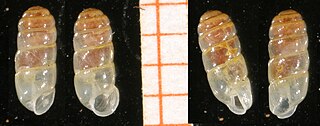
Gulella is a genus of very small air-breathing land snails, terrestrial pulmonate gastropod mollusks in the family Streptaxidae.
Leiostyla is a genus of small air-breathing land snails, terrestrial pulmonate gastropod mollusks in the family Lauriidae.
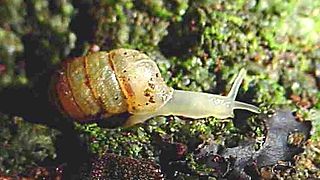
Streptaxidae is a family of carnivorous air-breathing land snails, terrestrial pulmonate gastropod mollusks in the clade Stylommatophora. Six Streptaxidae subfamilies are accepted in the 2005 taxonomy of the Gastropoda by Bouchet & Rocroi.

Camaenidae is a family of air-breathing land snails, terrestrial pulmonate gastropod mollusks in the superfamily Helicoidea, the typical snails and their allies. This is one of the most diverse families in the clade Stylommatophora.

Enidae is a family of air-breathing land snails, terrestrial pulmonate gastropod mollusks.

Vitrinidae is a family of small, air-breathing land snails, terrestrial pulmonate gastropod mollusks in the superfamily Limacoidea.

Bothriembryontidae is a family of air-breathing land snails, terrestrial pulmonate gastropod mollusks in the superfamily Orthalicoidea.

Paralaoma servilis is a species of very small air-breathing land snail, a terrestrial pulmonate gastropod mollusk or micromollusk in the family Punctidae, the dot snails.
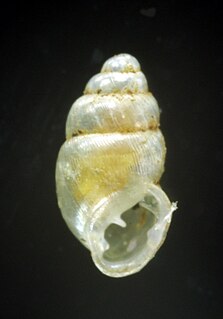
Carychium is a genus of very small air-breathing land snails, terrestrial pulmonate gastropod mollusks in the family Ellobiidae.
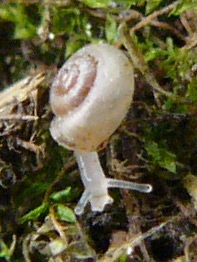
Pupilloidea is a superfamily of small and very small air-breathing land snails, terrestrial gastropod mollusks in the infraorder Pupilloidei.

Ganesella is a genus of air-breathing land snails, terrestrial pulmonate gastropod mollusks in the subfamily Camaeninae of the family Camaenidae.

Gittenedouardia is a genus of air-breathing land snails, terrestrial pulmonate gastropod mollusks in the family Cerastidae.
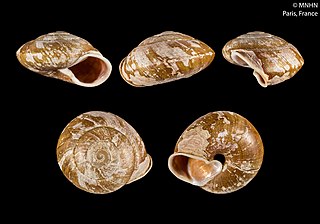
Isomeria is a genus of air-breathing land snails, terrestrial pulmonate gastropod mollusks in the family Labyrinthidae.

















